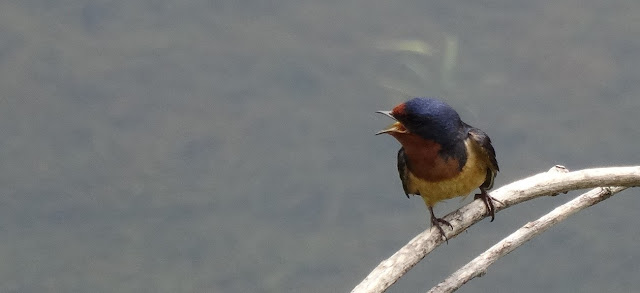A volunteer plant in the area around the pond - - Maltese Cross.
7/31/2021
maltese cross
A volunteer plant in the area around the pond - - Maltese Cross.
7/28/2021
convivial ducks
This summer has been very scant on rainfall so far. The pond water level is currently low, and there is plenty of algae floating. But the rocks are always good places for sharing the sunshine. Female Mallard and Hooded Merganser have raised their young broods here, and shared the big rock today.
7/23/2021
mountain mint
7/20/2021
evening primrose
7/19/2021
7/17/2021
royal catchfly
Royal Catchfly Silene regia makes its bright red flowers stand out among the white and purple wildflowers now blooming.
This family of plants was named 'catchfly' because it has a sticky seed pod behind the flower. Little flies, gnats, and other tiny insects get stuck on the sticky pod or stem.
Butterflies also pollinate this wildflower.
7/15/2021
mulleins
7/11/2021
barn swallows
Barn Swallows hunt over the pond, where they catch flying insects mid-air. To do this efficiently, they fly with their wide beaks open.
This pair found a good amount of food here, and decided to make their nest nearby. They gathered mud from the shore to paste pieces of grasses to a vertical surface in a barn, outbuilding, or nearby structure.
When their eggs hatch, the pond area will be a resource for mosquitoes and other flying insects to feed to their chicks.
7/07/2021
white wildflowers
Sitting near the pond, one can gaze out at flowering plants among the green grasses, rushes, and reeds. Mountain Mint, Swamp Milkweed, and Queen Anne's Lace are among the ones blooming now.
7/04/2021
yellow loosestrife
Small yellow wildflowers, brightening the green grasses and rushes around the pond now, are River Loosestrife Lysimachia hybrida, or Lowland Yellow Loosestrife. This plant bloomed last year, and came back stronger with more stems this season. Lysmachias produce floral oil rather than nectar. These plants are also pollen hosts for Macropis bees; the bees specialize in using a mixture of pollen and floral oil to produce offspring. read more at U of MN Extension
















